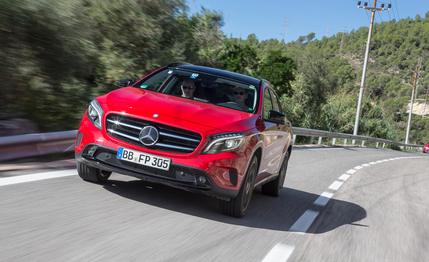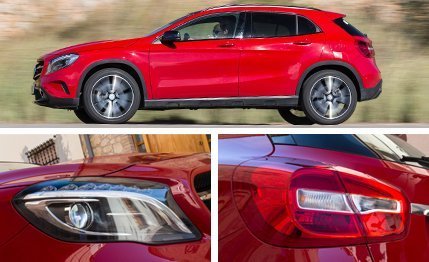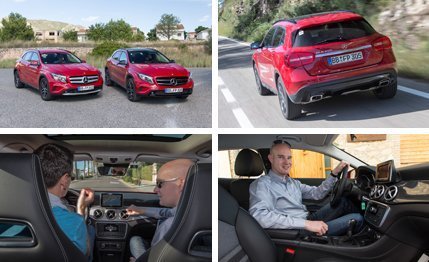 First Ride
First Ride
The 2015 Mercedes-Benz GLA-class has a lot riding on its relatively diminutive shoulders. Based on the same bones that underpin the CLA-class compact sedan, the GLA is charged with a task no less important than blasting Mercedes volumes right past those of Audi and BMW in the world’s most important markets. But it’s not time to tally sales figures yet—the GLA-class is still in its pre-production stage. Its European debut is a few months away, and we’ll have to wait nearly a year before it reaches U.S. dealers. But we were given the opportunity to sit shotgun with Mercedes engineers, spending two days with the team near Barcelona, Spain, as it conducts the final rounds of development testing.
In addition to the CLA, the GLA is a close relative of the not-for-America A-class as well as the B-class that will be offered here only as an EV. The previous iterations of those small cars utilized an innovative but architecturally limiting sandwich-floor construction—it could house alternative powertrain bits as well as swallow conventional models’ engines in forward collisions—that’s been tossed in favor of a simpler, more flexible architecture. This is surely one of the shrewdest decisions ever made within the walls of Daimler's Stuttgart-Untertürkheim headquarters. More variations can now be spun from the same pile of parts, vastly improving the economies of scale, and sales of the new A-, B-, and CLA-classes are said to have surpassed all expectations. And that’s before the GLA gets factored in. In North America, the GLA could very well be the bestselling Mercedes-Benz ever, combining as it does our loves of cheaply acquired luxury and jacked-up hatchbacks, er, crossover SUVs.

Our experience with Mercedes’ GLA operatives included extended and very spirited rides in the hills above the Costa Daurada. At this late stage in development, an engineering drive such as this isn’t expected to uncover major issues, although any serious flaws would certainly be addressed. Instead, the engineers we rode with were looking for squeaks and rattles, testing color and trim consistency across several examples, and testing the overall durability of components. Indeed, on one GLA, we immediately noticed that its body-cladding pieces were rendered in several shades of gray. They are, of course, supposed to match. Naturally, this didn’t escape the eyes of the Mercedes team, and the supplier will be called and told that it needs to improve the quality of its pieces—and quickly. But even if the cladding were fine, once you step into the GLA, it’s pretty clear that this is a budget Benz. While the utelet’s innards are attractive, they share much with the CLA’s in terms of materials, which we’ve found to include some chintzy bits.
Outside, the GLA’s flaring intakes, massive grille with central star, and protruding taillights hint at Mercedes’ aggressive ambitions for the crossover, and they also serve as visual indicators of its dynamic goals. While we reserve final judgment until we drive the GLA, it handled the sinewy roads of our route with aplomb, as chief engineer Rüdiger Rutz flogged the thing within an inch of its life. In Europe, the GLA will be available with two ride heights, but only the taller one will be offered in the U.S., so it can be classified as a light truck.
Either way, the front-end hardware includes components shared with the high-performance CLA45 AMG. At least partly because of this, the GLA didn’t exhibit the sort of body roll typically associated with driving crossovers hard, even small ones. We also noticed that Rutz rarely had to adjust his steering inputs, indicating some precision to the rack, which is different from the CLA’s Direct Steer setup. The examples we experienced seemed to ride on the firm side, but we expect American GLAs to be softened a bit to cater more to the tastes of people who shop at the Coach Factory Store.

The all-wheel-drive 4MATIC system will be the sole driveline at launch, but a front-driver will come along within a few months after that. We rode in both. The 4MATIC model is being engineered to tackle light off-road duties, although we can’t imagine any GLA will see surfaces worse than a lumpy lawn. The rear wheels can receive power even at highway velocities, and the system will allow drivers to hang out the tail a bit when the stability control system is in its most lenient mode.
The U.S. will be served the GLA in two strengths, and if you’ve studied the spec sheets of the CLA lineup, the engines will be instantly familiar. The GLA250 will have a 2.0-liter four-cylinder turbo with 208 horsepower and 259 lb-ft of torque. The GLA45 will come online at the same time with standard 4MATIC, a 355-hp 2.0-liter turbo four, and a more brutish personality hinted at by a concept shown at the L.A. auto show last month. Both GLA models will make use of a seven-speed dual-clutch automatic. (European options will include less-powerful gasoline engines, a selection of ultra-efficient four-cylinder diesels, and a six-speed manual.) The GLA250 moves out with some authority, although we would discourage anyone from drag-racing, say, a Volkswagen GTI.
As Mercedes-Benz moves aggressively into lower price classes, it naturally risks its reputation as the archetypical luxury brand. The GLA therefore needs to be as sturdy and refined as the rest of Merc’s SUV lineup—after all, the brand loves to state in its advertising that it builds "the best or nothing." While this development drive suggests that the GLA is poised to build on the momentum of Mercedes’ latest small cars, we’ll need to slide behind the wheel before we can determine whether it’s the best at anything.